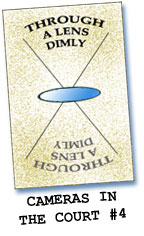CAMERAS IN THE COURT #4
by Dick Kraus
Newsday Staff Photographer (retired)
Our editors often question why we spend so much time in the court buildings,
before and after court is in session. They thought that if a trial started
at 10 am and ended at 4 or 5 pm, we should utilize the time away from court
pursuing
other avenues of journalism. We just seem to be unable to convince them of
the need to schmooze with lawyers, judges, court buffs and especially, the
court officers.
The extra hours of drinking coffee and shooting the bull with all of these
groups pays off in the long run. Whenever we have a photo with a court officer
in the
frame, we always make up a print for him or her. I don’t know how many
times these small efforts have saved our bacon.
The court buffs are a small group of retired men and women who
enjoy gathering at the courthouse each day, and they collectively
decide which trial might prove
the most interesting. They sit in on these trials and are often sought after
by lawyers who want their input about their summations to the jury or how they
felt a jury would respond to what the attorney said. The court buffs are a
vital source of information for us photographers as well,
because they know every nook
and cranny of the buildings. They know everything that’s going on. And
they can and do frequently point out people in the halls who are family members
or friends of the victim or the defendant.
Getting the confidence of the prosecutor and the defense attorney
often results in “off the record” tips on upcoming witnesses or evidence. This
information can’t be shared with the reporters, unfortunately, or the sources
would soon dry up. But, they come in handy, because when the appropriate time
comes, we know it’s going to happen and we won’t be stuck with a
200mm lens on the camera when the prosecutor whips out a newly discovered piece
of evidence and he’s right on top of you.
Obliging court officers have tipped us off to the routes through
the building that they are going to take witnesses that we
might not be allowed to photograph
in the courtroom. Common sense must be applied here. If the witness is
underage or involved in a sex crime or is an undercover cop,
making a photo is detrimental
to the profession of photojournalism.
Covering stories in court requires a good deal of tact and understanding.
Foregoing ethics and common decency in order to get one picture today
must be weighed
against the possibilities of not getting ANY pictures tomorrow. Some
of us in NY State
have had to do battle with a victim’s rights advocacy group. They
would like to see us banned from the courtroom, altogether. They feel
that the victim’s
family has a right to privacy. As I have state before and have voiced
many times to
such advocates, the courtroom IS a public forum. I feel that a photograph
of a bereaved family member in court makes the point to our readers that
these are
flesh and blood people involved here, with flesh and blood emotions.
Our writers point out in their stories that the parents of the victim
or the defendant cried
during testimony. A picture can do it even more eloquently.
But, even here, common decency should be exercised. During the
coverage of a trial of a young man accused of raping and
murdering a teenage girl,
I
had discretely
taken pictures of the girl’s mother weeping. The photo ran and I received
a lot of heat from a particularly vocal victim’s rights advocate who was
attending each session. I pointed out to him, that I pointed my camera to the
floor during the testimony of the medical examiner who was graphically describing
finding semen in the girl’s anus. The purpose of this testimony indicated
that the young girl was not raped but was a willing partner at that point. (I’m
not going into further details, here, to make this point) The girl’s mother
was hysterical, but I didn’t think it required me to take her picture.
When the trial was concluded, and the accused was found guilty,
I was photographing the victim’s parents out in the hall. The loud-mouthed advocate tried,
once again, to intervene. But, the mother said for all to hear, that I was welcome
to come to their home, afterward, for a cup of coffee. Apparently, the only one
who was offended by my photos was the advocate.
Dick Kraus
newspix@optonline.net
http://www.newsday.com
|

